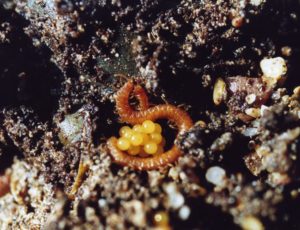News
SECRETS OF A SCOTTISH CENTIPEDE
Blind Brora centipede unlocks clues to the origins of creepy crawlies
The genome sequence of the centipede Strigamia maritima has enabled an international team of scientists to reconstruct many features of the genetic make-up of the ancestral arthropod.
In a report published today in the journal PLoS Biology, the team reveal for the first time some of the reconstructions and rearrangements that have been connected with the diversification of arthropods over millions of years.
The Arthropoda are the most numerous, species-rich group of animals on Earth with many features that effect human interests: such as pollinating our crops, spreading diseases via biting us, or gracing our dining tables as lobster thermidor. Yet there is still much to learn about the origins and evolution of these animals, including insects (flies, beetles and wasps), crustaceans (crabs and lobsters), chelicerates (spiders and mites) and myriapods (centipedes and millipedes).
Over a decade ago a team from Cambridge University, headed by Prof Michael Akam, started making the long trip up to Brora on the coast of the Moray Firth to lie on their bellies on the beach, digging under the pebbles to hunt out their favourite centipede.
Strigamia is favoured by scientists for the accessibility of its nests, from which embryos can be gathered for study – making the species an ideal candidate for obtaining the first genome sequence from a myriapod, and opening the door to new understandings of the developmental biology and ecology of these secretive animals.
The genome sequence from this Scottish population has since been the focus of detailed analysis for a team of over 100 scientists from 15 countries.
Lead co-author of today’s report Dr David Ferrier, of University of St Andrews’ Scottish Oceans Institute, said:
“This genome of Strigamia has proved to be particularly valuable in deducing the content of important gene families in the ancestral arthropod, this ancestor then being the starting point for the evolution of the huge diversity of arthropods that we currently see today.
“There has been a high turn-over in arthropod gene and genome organisation, with lots of rearrangements and plenty of gene losses during the evolution of animals like the insects. The sorts of reconstructions that have been made possible by this new myriapod genome provide a foundation for delving more deeply into the biology of these genetic changes to see how they were linked to the diversification of the incredible range of body forms and modes of life that we now find in the arthropods.”
The interplay between the evolution of the huge biodiversity represented by these animals and the information encoded in their genomes is poorly understood. To a certain extent this has been hindered by a biased sampling of genome sequencing so far, with a major focus on insects and much poorer coverage of the other arthropod groups, with the myriapods being completely neglected, until now.
The popular ‘work-horse’ of geneticists, cell and developmental biologists is the fruit fly, Drosophila melanogaster, but with genome sequences such as this from Strigamia researchers can demonstrate that much has changed during the evolution of the fly genome, as well as insect genomes more generally. This makes a strong case for studying a wider range of species to develop a deeper understanding of animal biology.
This centipede genome also provides striking examples of differences in how insects and myriapods independently conquered the land. For example, their sense of smell, or olfaction, is achieved by different sets of molecules.
Another striking observation is that this centipede is blind, having lost the genes involved in vision. Intriguingly these genes are also involved in controlling circadian rhythms in other animals. Since Strigamia still has circadian rhythms this centipede must be controlling them by a completely different, as yet undiscovered, molecular mechanism.
Visits to Brora beach are likely to continue for years to come as scientists continue to work to unravel more of the mysteries that this new genome sequence has opened up.
The paper is: The First Myriapod Genome Sequence Reveals Conservative Arthropod Gene Content and Genome Organisation in the Centipede Strigamia maritima. Ariel Chipman and David E.K. Ferrier et al. PLoS Biology 12(11): e1002005. Doi: 10.1371/journal.pbio.1002005

Resurrecting the sponge ghosts
Calcisponges have a ParaHox gene and dynamic expression of dispersed NK homeobox genes.
A new study, published today in Nature, reports the analysis of new sponge genome sequences that reveal the presence of genes previously unknown from so early in animal evolution.This means that the earliest animal, living over 600 million years ago, was genetically more complex than previously appreciated.
News Item:
The Amazing Amphioxus
An evolutionary leap made at the bottom of the ocean over 500 million years ago gives new insights into the causes of human diseases such as diabetes, cancer and neurological disorders, according to newly published research from scientists at the Universities of St Andrews and Dundee.
More information: http://biology.st-andrews.ac.uk/newsItem.aspx?ni=1243
Download the paper: http://rsob.royalsocietypublishing.org/content/2/7/120103.abstract

